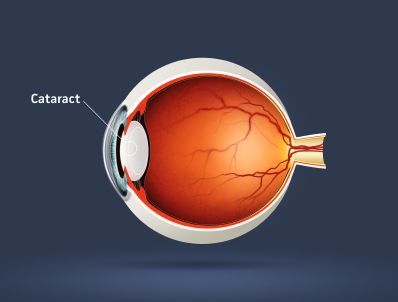ABOUT CATARACTS

What is Cataract?
A cataract is the clouding of the natural human lens. Cataracts are among the most common age-related eye conditions; it is estimated that over 60% of Americans will develop a cataract at some point during their lifetime. Anyone can get a cataract. Cataracts occur most often in people over 45 years old and are even more common in people over the age of 65. Cataracts may also develop as a side effect of certain medications, such as corticosteroids. Some children are born with congenital cataracts. Other causes for cataract formation can include ocular trauma or previous retinal surgery.
Some symptoms of cataracts include:
- Blurred or distorted vision
- Sensitivity to light, especially bright lights from oncoming car headlights
- Need to get closer to see distance objects, such as road signs
- Loss of depth perception
- A change in the color or your pupil to a milky white or yellow
- Glare and/or light sensitivity
- Continual changing of glasses prescriptions
Fortunately, cataracts are highly treatable. In the early stages, glasses & contacts will help the problem. As the cataract progresses, vision quality will usually decrease to the point where surgery is the best option. Before cataract surgery, a patient will have to schedule a consultation with Dr. Ernest. Dr. Ernest takes this consultation very seriously-this is an opportunity for the patient to not only share their health history but also explore the best lens options for their surgery and their specific lifestyle.
How is a Cataract Removed?
Cataract surgery is an outpatient procedure performed using the most advanced methods available. The procedure is painless and involves no stitches or injections. This suture-less, self-sealing cataract removal method was developed by Dr. Ernest. During cataract surgery, an ultrasound is used to break up the cloudy lens and the lens pieces are then removed. A new intraocular lens (IOL) is implanted using a tiny, self-sealing incision that heals very quickly. Because no blood vessels are cut, there is no bleeding. There are no stitches to remove and only a local or topical anesthesia is used. Patients heal very quickly and resume most normal activities the next day.
Since cataract surgery is such a common procedure, there are very few complications reported. The most likely complication is a rupturing of the capsule around the lens during the procedure. This situation does not always result in a loss of vision, and it should be emphasized that rupture is very rare. In fact, the usual rate of this complication for cataract surgery is about 1 in 100; Dr. Ernest is proud of a complication rate that is only 1 in every 1,000-2,000 cases. He is also the author of a published article that illustrates methods for decreasing the chance of this complication.
No-Stitch Cataract Removal
Dr. Ernest is one of the originators of the no-stitch technique for cataract surgery. In use since February 1990, Dr. Ernest believes that this type of cataract surgery is the safest and most effective technique available and offers several benefits over conventional surgery:
- Eliminates the need for stitches by using the eye’s internal pressure to keep the incision tightly closed.
- Eye’s shape is not distorted at all, as with older techniques.
- Patient is able to return to their normal activities the day after surgery, including bending, lifting, housework and golfing.
- Patient can receive a new prescription for eyewear only 14 days after surgery.


